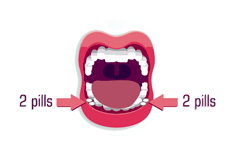What is medication abortion?
These medications are approved for use by Health Canada. Research studies have shown this treatment to be a safe and effective method of ending a pregnancy.

Medication Abortion Packaging
The first medication is Mifepristone (Step 1) it is one tablet and comes packaged in the green box.
The second medication is Misoprostol (Step 2) it is 4 tablets and comes packaged in the orange box.
How effective is medication abortion?
7 weeks, or 49 days ………… the medications are 92% to 99% effective
8 weeks, or 56 days ………… the medications are 91% to 98% effective
9 weeks, or 63 days …………. the medications are 87% to 98% effective
Who should not use medication for their abortion?
- You are unsure about your decision to end your pregnancy
- You do NOT have access to emergency medical care. You must be able to get medical help in
the 14 days after you take the mifepristone tablet - You have an intrauterine contraceptive device (IUD) in your uterus
- You have any allergies to mifepristone or misoprostol
- You have a chronic adrenal disease
- You take corticosteroids on a regular basis
- You have a bleeding problem or take a blood thinner (anticoagulant like coumadin)
- You have inherited porphyria. This is a blood disease that causes skin symptoms as a result of oversensitivity to sunlight
- You have uncontrolled asthma
How do I to take mifepristone (Step 1)?
How do I take misoprostol (Step 2)

Where to place the misoprostol tablets.
To take misoprostol (Step 2):
– First take a sip of water to moisten your mouth.
– Then place all 4 pills in your mouth with 2 pills on the left side and 2 pills on the right side in between your gum and cheek (see diagram).
– Set a timer for 30 minutes and let medication begin to dissolve.
– After 30 minutes take a sip of water and swallow everything in your mouth.
What are the side effects of medication abortion?
Pain: Pain in the abdomen and the pelvic area typically begins within 3 hours of taking misoprostol (step 2) although it is possible to experience cramps and pain after mifepristone (step 1). The pain may be similar to your period, but may be worse if you usually have painful periods.7 The further into the pregnancy you are, the more uncomfortable you may feel. You may even experience back pain.
Headache: Headaches are another common side effect of medication abortion. Some people may also feel dizzy. The dizziness, headaches, and weakness are caused by hormonal fluctuations brought about by the misoprostol (step 2). The headaches and the weakness will likely last for 2 days and the dizziness should subside in 1 day. The best thing to do is allow yourself some downtime to rest, this process can take a toll on your system.
Nausea and Vomiting: Feeling nauseous or vomiting is common during a medication abortion. Using the misoprostol (step 2) may make your nausea worse. That nausea may last for two days.
Diarrhea: Misoprostol (step 2) may cause diarrhea, which involves having 3 or more bowel movements that are loose or watery in a single day. Should you get diarrhea, drink lots of water to stay hydrated.
Fever and Chills: Some people may have fever and/or chills after taking mifepristone (step 1) and misoprostol (step 2). The fever usually only last for about one day. If your fever is greater than 100.4°F and lasts longer than 24 hours after using misoprostol (step 2) contact your clinician as soon as possible.
Infection: Abortion pills have low risk of infection, however it may be possible to develop an infection while using the medication . A persistent high fever above 100.4 F, pain, and severe bleeding are signs of an infection. You should seek medical attention as soon as possible if you suspect you may have an infection. If left untreated, an infection may result in more serious and potentially fatal health complications.
Incomplete Abortion: Sometimes, the medication may not work exactly as planned. This may result in incomplete expulsion of the pregnancy. If this happens, surgical intervention may be required. This happens in approximately 2.5 to 5.1% of all people who have a medication abortion. Watch out for prolonged pain, pain felt when you press down on the abdominal region, cramps, or continued bleeding in the weeks following the abortion. Having your follow up blood work 7-10 days after you use mifepristone (step 1) is the best way to know for sure if the medication worked and the process is going as expected.
Continued Pregnancy: Very rarely, in less than 2% of people, the abortion pills may not end the pregnancy. If you continue to experience pregnancy symptoms, it could be a case of failed or missed abortion. This means that the pregnancy is continuing to grow. The pills become less effective as you near the 9th week of pregnancy.
How long after having a medication abortion can I become pregnant?
If you would like to use birth control to reduce your risk of pregnancy, please contact SHORE Centre to learn more about your options. The clinician you saw for your medical abortion will be able to prescribe all methods of birth control at your follow-up appointment.
How long after having a medication abortion can I use tampons, a menstrual cup or resume sexual intercourse?
The exception to not putting anything into the vagina would be for people who choose the vaginal ring for birth control, they should insert it 1 day after taking misoprostol or as instructed by their clinician.
Who can I talk to for support?
If you have questions, concerns, or would just like to talk to someone at SHORE Centre you can book a session with one of our counsellors by calling 519-743-9360 Monday to Friday between 9:00 AM and 4:00 PM or you can request an appointment here: https://shore.inputhealth.com/ebooking.
Please note that our office is closed on Saturday, Sunday, and all statutory holidays. We will do our best to reply to all emails and phone messages in two business days or less.
For more information on taking care of yourself after an abortion click here.
References
Celopharma. (2016). Mifegymiso Medication Guide.
Costescu, D., Guilbert, E., Bernardin, B., Black, A., Norman, W. V., Pymar, H., Society of Obstetricians and Gynaecologists of Canada. (2016). Medical Abortion. Journal of Obstetrics and Gynaecology Canada, 38(4), 366-389. doi:10.1016/j.jogc.2016.01.002
Society of Obstetricians and Gynaecologists of Canada. (2016). Mifegymiso Online Training Modules.
Creinin, Mitchell D., Jill L. Schwartz, Helen C. Pymar, and Wendy Fink. “Efficacy of mifepristone followed on the same day by misoprostol for early termination of pregnancy: report of a randomised trial.” BJOG: An International Journal of Obstetrics & Gynaecology 108, no. 5 (2001): 469-473.Ending pregnancy with medications. U.S. National Library of Medicine.
Diarrhea During Pregnancy. American Pregnancy Association.
El-Refaey, Hazem, Dhamnasekar Rajasekar, Mona Abdalla, Lynda Calder, and Allan Templeton. “Induction of abortion with mifepristone (RU 486) and oral or vaginal misoprostol.” New England Journal of Medicine 332, no. 15 (1995): 983-987.
Ending pregnancy with medications. U.S. National Library of Medicine.
Kruse, Beth, Suzanne Poppema, Mitchell D. Creinin, and Maureen Paul. “Management of side effects and complications in medical abortion.” American journal of obstetrics and gynecology 183, no. 2 (2000): S65-S75.
Medical abortion:The Abortion pill up to 10 weeks. British Pregnancy Advisory Service.
Possible Physical Side Effects After Abortion. American Pregnancy Association.
Rørbye, Christina, Mogens Nørgaard, and Lisbeth Nilas. “Medical versus surgical abortion: comparing satisfaction and potential confounders in a partly randomized study.” Human Reproduction 20, no. 3 (2005): 834-838.
Shannon, Caitlin S., Beverly Winikoff, Richard Hausknecht, Eric Schaff, Paul D. Blumenthal, Deborah Oyer, Heather Sankey, Jessica Wolff, and Rachel Goldberg. “Multicenter trial of a simplified mifepristone medical abortion regimen.” Obstetrics & Gynecology 105, no. 2 (2005): 345-351.
Spitz, Irving M., C. Wayne Bardin, Lauri Benton, and Ann Robbins. “Early pregnancy termination with mifepristone and misoprostol in the United States.” New England Journal of Medicine 338, no. 18 (1998): 1241-1247.
Tang, Oi Shan, Carina CW Chan, Ernest HY Ng, Sharon WH Lee, and Pak Chung Ho. “A prospective, randomized, placebo‐controlled trial on the use of mifepristone with sublingual or vaginal misoprostol for medical abortions of less than 9 weeks gestation.” Human Reproduction 18, no. 11 (2003): 2315-2318.
The Safety of Abortion. National Abortion Federation.
